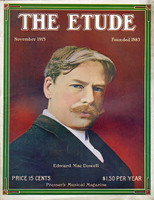By Grace Busenbark
Some of my pupils, who, "having eyes, yet saw not," consequently had difficulty in reading music.
One used to look at a chord four or five times before she got it correctly and had to stop to pick out each individual note of an arpeggio or simple phrase. This made her playing sound timid and hesitating and impaired her sense of rhythm.
Another, less cautious, would play the notes hastily, recklessly (and generally wrongly), jabbing at them again and again until her ear told her they were right, without looking to see or being able to see when she looked.
These types of two extremes of poor reading were repeated with variations among the class. Although opposite in effect, both kinds of faults were caused by the same condition: the inability of the reader to "get" what she looked at. The trouble was not with defective eye-sight, but with defective eye-thought; in other words, the mental powers controlling the vision were, in both cases, being only partly used.
I had faith in all my pupils, however, and so set about arousing their latent faculties by means of the following method—sugar-coated as a game.
At the class-meeting half the pupils were given music and half were given pencil and paper. Each of the latter then chose a partner from among those with the music. The game was for those with the pencils to point quickly to any note or chord on the page, at which their partners must give one glance, then look away and tell the notes from memory. The child who pointed kept count of the number of times his partner got correct notes in one glance. At the end of five minutes the pupil with the longest list received a credit-mark. Then each exchanged occupations with his partner—the readers taking a turn at pointing and vice versa. The music was purposely unfamiliar to all and the "pointers" instructed to skip over the page at wide intervals, never allowing a second glance at the same note.
There were different stages of progress—from a single note to an entire measure or phrase.
At first some of the children were literally so "scatter-brained" that they could not even get one note at a single glance. When this became possible, through a little practice, the next step was two notes, either in thirds, octaves or a sequence. Then came three notes either in a chord or separately. Then four notes in the same way. Finally came the "stunt" of treble and bass combined, taking all tones to be played on one beat in both clefs. Of course this stage was not reached in one or two meetings.
Some of the children were so interested in the new game that they played it at home between class meetings, it being understood that in this way they could add to their list of credit-marks which received recognition at the end of each month.
The improvement in reading, concentration, and accuracy of playing was rapid and the power to "get" what they sought with minimum of time and effort was developed through a real use of it for the first time. In a few weeks they became so proficient that they could grasp an entire measure or phrase in a glance and write it from memory.
Thus was the difficulty conquered for a group of children, but some grown-ups might follow the plan to advantage. Collect your faculties. "If you have eyes and cannot see"—find out why. As the well-known advertisement says, "there's a reason." More music students might be excellent sight-readers if they had not stopped learning to read music just when they should have gone on.



